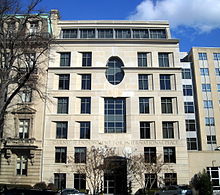 The Endowment's headquarters in Washington, D.C. | |
| Abbreviation | CEIP |
|---|---|
| Formation | December 14, 1910 |
| Founder | Andrew Carnegie |
| Type | Foundation |
| Legal status | Nonprofit organization |
| Purpose | To advance peace and international cooperation through analysis and development of new policy ideas[1] |
| Headquarters | 1779 Massachusetts Avenue NW, Washington, D.C., United States |
| Location | |
Region | Global |
| Methods | Nonpartisan policy research and analysis, briefing policymakers to disseminate independent analysis and policy ideas, support for unofficial and semi-official diplomacy through backchannel dialogues, training and mentoring fellows, incubating initiatives that become independent organizations, public events, development and distribution of digital content |
| Fields | International relations, peace and conflict studies, government and institutions, technology and international affairs, regional political economy, climate and energy |
President | Mariano-Florentino Cuéllar |
Chair of the Board of Trustees | Catherine James Paglia |
Revenue (2023) | $51,064,825[2] |
| Expenses (2023) | $45,424,424[2] |
| Website | carnegieendowment |
The Carnegie Endowment for International Peace (CEIP) is a nonpartisan international affairs think tank headquartered in Washington, D.C., with operations in Europe, South Asia, East Asia, and the Middle East, as well as the United States.[1] Founded in 1910 by Andrew Carnegie, the organization describes itself as being dedicated to advancing cooperation between countries, reducing global conflict, and promoting active international engagement between the United States and countries around the world. It engages leaders from multiple sectors and across the political spectrum.[3]
In the University of Pennsylvania's "2019 Global Go To Think Tanks Report", Carnegie was ranked the number 1 top think tank in the world.[4] In the 2015 Global Go To Think Tanks Report, Carnegie was ranked the third most influential think tank in the world, after the Brookings Institution and Chatham House.[5] It was ranked as the top Independent Think Tank in 2018.[6]
Its headquarters building, prominently located on the Embassy Row section of Massachusetts Avenue, was completed in 1989 on a design by architecture firm Smith, Hinchman & Grylls.
The chairperson of Carnegie's board of trustees is businesswoman Catherine James Paglia,[7] and the organization's president is former California Supreme Court justice Mariano-Florentino Cuéllar, who replaced CIA Director William J. Burns in 2021.[8]
- ^ a b "About the Global Think Tank". Carnegie Endowment for International Peace. n.d. Retrieved 2016-04-04.
- ^ a b "2023 Annual Report" (PDF). Carnegie Endowment for International Peace. 2023. Retrieved 12 March 2024.
- ^ Mitchell K. Hall, ed. Opposition to War An Encyclopedia of U.S. Peace and Antiwar Movements (2019) 1:108–110.
- ^ https://repository.upenn.edu/cgi/viewcontent.cgi?article=1018&context=think_tanks [bare URL PDF]
- ^ McGann, James G. (2 September 2016). "2015 Global Go To Think Tank Index Report". University of Pennsylvania. Retrieved 20 November 2018.
- ^ McGann, James (2019-01-01). "2018 Global Go To Think Tank Index Report". TTCSP Global Go to Think Tank Index Reports (16).
- ^ "Penny Pritzker to Conclude Tenure as Chair of Board for Carnegie Endowment for International Peace". Carnegie Endowment for International Peace. Retrieved 2023-09-23.
- ^ "About". Carnegie Endowment for International Peace. Retrieved 2018-10-11.